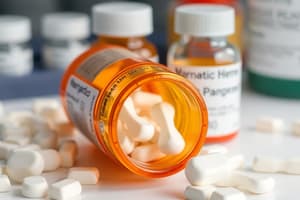Podcast
Questions and Answers
Which type of local anesthetic is metabolized by the liver and commonly ends with the suffix '-caine'?
Which type of local anesthetic is metabolized by the liver and commonly ends with the suffix '-caine'?
- Neither amides nor esters
- Both amides and esters
- Amides (correct)
- Esters
Which amide local anesthetic has the shortest duration among all the local anesthetics?
Which amide local anesthetic has the shortest duration among all the local anesthetics?
- Mepivacaine
- Prilocaine
- Lidocaine
- Articaine (correct)
Which of the following is a therapeutic effect of corticosteroids?
Which of the following is a therapeutic effect of corticosteroids?
- Gastric ulcers
- Fat redistribution
- Immunosuppression (correct)
- Acute adrenal insufficiency
Which of the following drugs is a competitive opioid antagonist used for emergencies?
Which of the following drugs is a competitive opioid antagonist used for emergencies?
Which of the following is one of the toxic side effects of morphine?
Which of the following is one of the toxic side effects of morphine?
Which schedule is heroin classified under?
Which schedule is heroin classified under?
What is the minimum alveolar concentration (MAC) of nitrous oxide?
What is the minimum alveolar concentration (MAC) of nitrous oxide?
Which route of administration involves intravenous, intramuscular, or subcutaneous administration?
Which route of administration involves intravenous, intramuscular, or subcutaneous administration?
What is the only route of administration that can achieve 100% bioavailability?
What is the only route of administration that can achieve 100% bioavailability?
Which of the following statements about local anesthetics is true?
Which of the following statements about local anesthetics is true?
How many milligrams of lidocaine are present in a carpule (1.8mL) of a 2% lidocaine (1:100,000 epinephrine) solution?
How many milligrams of lidocaine are present in a carpule (1.8mL) of a 2% lidocaine (1:100,000 epinephrine) solution?
What is the maximum dosage of lidocaine without epinephrine for a healthy patient?
What is the maximum dosage of lidocaine without epinephrine for a healthy patient?
Which technique can be useful in cases of truisms?
Which technique can be useful in cases of truisms?
Which nerve block anesthetizes the soft tissue buccal to molars?
Which nerve block anesthetizes the soft tissue buccal to molars?
Which nerve block anesthetizes the soft tissue facial to anterior teeth?
Which nerve block anesthetizes the soft tissue facial to anterior teeth?
Which nerve block anesthetizes the anterior teeth and premolars of the quadrant?
Which nerve block anesthetizes the anterior teeth and premolars of the quadrant?
Which type of antibiotic is chemically related to cephalosporins and may cause a cross-allergic reaction in patients allergic to cephalosporins?
Which type of antibiotic is chemically related to cephalosporins and may cause a cross-allergic reaction in patients allergic to cephalosporins?
Which antibiotic is commonly used for prophylaxis of infective endocarditis in patients with prosthetic cardiac valves?
Which antibiotic is commonly used for prophylaxis of infective endocarditis in patients with prosthetic cardiac valves?
Which antibiotic is NOT recommended for patients with liver disorders?
Which antibiotic is NOT recommended for patients with liver disorders?
Which drug combination should NOT be prescribed because the drugs cancel each other out?
Which drug combination should NOT be prescribed because the drugs cancel each other out?
Which of the following describes the distribution of a drug across three body water compartments?
Which of the following describes the distribution of a drug across three body water compartments?
Which phase of drug metabolism reactions involves the addition of polar side chains to the drug?
Which phase of drug metabolism reactions involves the addition of polar side chains to the drug?
Which of the following is true about drug elimination?
Which of the following is true about drug elimination?
Which of the following drug interactions can lead to an increased risk of bleeding?
Which of the following drug interactions can lead to an increased risk of bleeding?
Flashcards are hidden until you start studying
Study Notes
Pharmacology of Local Anesthetics for INBDE
- Local anesthetics can be categorized into amides and esters.
- Amides are metabolized by the liver and commonly end with the suffix "-caine."
- Important amide local anesthetics include lidocaine, mepivacaine, articaine, prilocaine, and bupivacaine.
- Esters are metabolized in plasma by pseudocholinesterase enzymes and also end with the suffix "-caine."
- Important ester local anesthetics include benzocaine, cocaine, and procaine.
- Pharmacodynamics of local anesthetics involve blocking sodium channels in neurons to prevent depolarization and signal pain.
- Non-ionized forms of local anesthetics can cross the neuron membrane to block sodium channels.
- Local anesthetics are less effective in inflamed tissue due to lower pH and excess H+ ions.
- Pharmacokinetics describes how the body responds to local anesthetics.
- Protein binding affects the duration of action.
- The pKa of a local anesthetic affects its onset of action.
- The dosage of local anesthetics can be calculated based on the concentration of the solution.
Studying That Suits You
Use AI to generate personalized quizzes and flashcards to suit your learning preferences.


